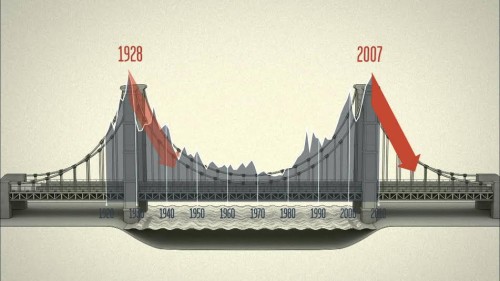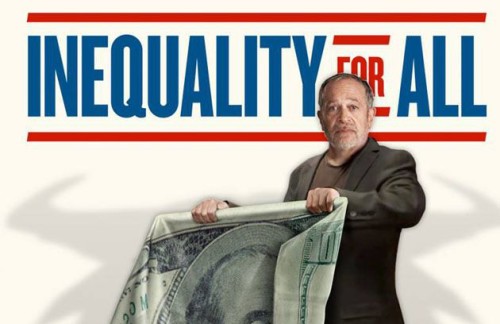Written by Rachael Johnson.
Inequality for All (2013) is not only one of the most important American documentaries made in the last few years; it is also–surprisingly, in light of its bleak subject matter–one of the most enjoyable. This is due, in great part, to its likeable presenter, political economist and academic Robert Reich. Inequality for All addresses the most burning issue facing the United States in the second decade of the 21st century–wealth disparity and the wage gap. It is a subject that has absorbed Reich for many years. Currently professor of public policy at UC Berkeley, Reich served as Secretary of Labor under Bill Clinton in the early nineties. Inequality for All is based upon Reich’s book Aftershock (2010) and structured around a wealth and poverty class he teaches at his university. The documentary features archival footage and moving commentary by middle-class Americans affected by the 2008 economic crisis as well as revealing interviews with members of the 1 percent. Directed by Jacob Kornbluth, it looks good, moves fast, and delivers its message plainly.
The film’s primary aim is to raise awareness. “Of all developed nations today, the United States has the most unequal distribution of income and wealth–by far–and we’re surging towards an even greater inequality,” warns Reich. The figures are astonishing: 400 Americans are richer than half the population of the United States. Reich is not a socialist. He does not want to jettison American capitalism but reform it. Although it is clear that he is morally driven, Reich underscores that the unfair state of things does not make economic sense: “What makes an economy stable is a strong middle class…The most important thing to understand is that consumer spending is 70 percent of the United States economy and the middle class is the heart of that consumer spending.” He also reminds us that extreme economic inequality endangers democracy.

Expertly steering the viewer through modern US economic history, Reich chronicles the decline of its middle class. In fact, he argues for a return to the post-war past. The average American middle-class worker in the prosperous decades following World War II enjoyed good wages, and income disparity was not extreme. The income and wealth gap between those at the top and the average middle-class worker began to widen, however, with deregulation and union-breaking Reagan. Technology and globalization were other contributing factors. The American middle class, Reich explains, coped with their decline in three ways: Women began working in the late seventies in great numbers, workers worked longer hours and borrowing increased. Reich describes the entrance of young mothers into work a “social revolution” but asserts that the majority went to work out of sheer financial necessity, to bolster their household income, not because they were granted new professional opportunities. The coping mechanisms employed by the middle class masked an insecure economic system. An image of a suspension bridge and graph is used to illustrate two major peaks in wealth disparity–pre-crash 1928 and 2007. Crucially, the much-trumpeted trickle-down effect is exposed as a myth and the taxation system revealed as insanely unfair.

Through interviews with ordinary men and women affected by the 2008 financial crisis, we see the human face of this modern tragedy. They include Erika Vaclav, a married woman with two children forced to live with friends of her husband after they lost their condo and he was laid off. A Costco employee, she earns $21.50 an hour and has $25 in the bank. Another woman interviewed, a litigation assistant who cannot save–although she and her partner work- speaks of single mothers she knows who work three jobs just to pay the rent. Incidentally, it would have been helpful if Reich had also addressed the criminal gender wage gap in the United States.
An interviewee at the other end of the socio-economic spectrum is venture capitalist Nick Hanauer. Hanauer is a refreshingly honest member of the 1 percent. He confesses that he makes a stupid amount of money and observes that fewer members of the majority middle class are buying his product. As Reich notes, this is a serious problem as a healthy economy relies on middle class spending power. Hanauer further makes the extraordinarily truthful statement that the wealthy are not, fundamentally, the job creators: “When somebody calls themselves a job creator, they’re not describing the economy…What they’re really doing is making a claim on status, privileges and power.” For both Hanauer and Reich, it is the middle class who are “the center of the economic universe.” A well-educated, unionized, well-paid labor force, Reich suggests, is the key to a just, prosperous society.

There is not a dull moment in Inequality for All. The illustrative infographics employed are understandable and attractive while Reich, like all great teachers, communicates his ideas in a clear, dynamic fashion. He comes across as a charming man. From the start, he refers to his diminutive size (Reich has a condition called Fairbanks disease). Of the Mini Cooper he drives, he notes, “we are in proportion…together…facing the rest of the world”. Reich makes for a witty, erudite presenter but personally I would have liked more anger- and a call for accountability. The empathy is abundantly evident though. Reich explains that a Freedom Rider friend from childhood inspired him to stand up for those less privileged. The documentary ends with the professor celebrating his last class with his understandably admiring students. Some may find it a little too upbeat and cheesy when we see Reich do a little dance to Dolly Parton’s 9 to 5. He’s an encouraging rather than narcissistic teacher, however, and the end does fit with his populist message. It’s an invitation to dance and get involved.
Inequality For All is an absorbing, entertaining documentary as well as a valuable educational tool. Remember this insane truth: 400 Americans are wealthier than half the population of the United States.


